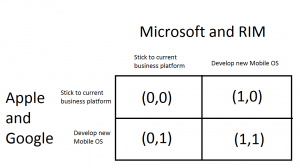Major Mobile Phone Companies in the Prisoner’s Dilemma
In today’s world, technology is an ever-growing part of the population’s daily lives. Since Martin Cooper and Motorola invented the first mobile phone in 1973, mobile technology has been rapidly developing. The last two decades have yielded rapid changes in mobile technology. Research in Motion (RIM) dominated the mid-2000s with Blackberry smartphones, but in 2007, Apple changed the world as we know it today. The iPhone revolutionized the mobile device market with its capacitive touch screen and powerful internet capabilities. It was the mobile device to be able to view full internet pages. Apple invented the iPhone and its other mobile devices because it believed that the world was starting to enter the “post-PC” era (Topolsky), in which the bulk of our daily computing is completed on a handheld device rather than a desktop and keyboard. Google purchased the start-up company Android in 2005 to build its mobile portfolio because it believed that “wireless [was] the next frontier in search” (Elgin). Both companies had different reasons for investing in mobile technology, but both revolutionized the cellphone and other mobile technology as we knew it. During this time, Microsoft and RIM dominated the mobile market, but both knew that the playing field was about to change.
Once the iPhone took off in 2007 and Android soon thereafter, Microsoft and RIM entered into the prisoner’s dilemma aspect of game theory. The diagram below has 0’s and 1’s. 0 represents a business’s decision to not develop a new mobile operating system (OS) and stick to the business’s current business platform whereas a 1 represents the decision to move forward and develop a new mobile OS. Prior to the 2005 purchase of Android, one can argue that all four companies were in Nash Equilibrium at (0,0). With the release of iOS and Android, Apple and Google both moved into the row Develop new Mobile OS while Microsoft and RIM were stuck in the Stick to current business platform column. Microsoft and RIM’s decision allowed Apple and Google to cannibalize the mobile technology market. In 2010, Microsoft looked to move back into Nash Equilibrium with Apple and Google by releasing its new revamped mobile OS Windows Phone 7 (Carmody). The first Windows Phone 7 phones arrived November 8, 2011. Although Microsoft at least made steps forward to try to reenter Nash Equilibrium, it still could not regain its lost market share and the company struggles today to create momentum for its mobile phone platform. RIM on the other hand, waited until 2011 to even announce its new competitive mobile operating system, Blackberry 10, (Molen) and it has yet to be released. Phones are projected to reach carriers Q4 of 2012 or more likely Q1 of 2013. This move is RIM’s hope that it can reach Nash Equilibrium with the other three platforms and hit (1,1). In my opinion, Microsoft entered the game late and will always suffer for it, but RIM is to the point of no return. RIM needed to recognize in 2005 when Google purchased Android that changes needed to be looked into. In 2007, when Apple announced the iPhone, RIM needed to invest in revamping their mobile operating system that same day if they had any hopes of clinging onto their dominating market share. Now, RIM only clings onto some of its corporate clients and a handful of general public users who are dependent on the classic Blackberry keyboard. More Apple and Google phones are becoming government, corporate and military certified. In my opinion, it is only a matter of time before RIM goes bankrupt or sells itself for its Blackberry Enterprise Server. All in all, the battle for mobile device market share created a real-world example of the prisoner’s dilemma for the major phone companies.
Works Cited
Barylick, Chris. “RIM, BlackBerry 10 and Its More Passionate Competitors.” RIM, BlackBerry 10 and Its More Passionate Competitors. N.p., n.d. Web. 30 Sept. 2012. <http://www.sdtimes.com/blog/post/2012/09/29/RIM-BlackBerry-10-and-its-more-passionate-competitors.aspx>.
Carmody, Tim. “Microsoft Announces First Windows Phone 7 Handsets.” Wired.com. Conde Nast Digital, 11 Oct. 2010. Web. 30 Sept. 2012. <http://www.wired.com/gadgetlab/2010/10/windows-phone-7-3/>.
Elgin, Ben. “Google Buys Android for Its Mobile Arsenal.” Bloomberg Businessweek. Businessweek.com, 16 Aug. 2005. Web. 30 Sept. 2012. <http://www.businessweek.com/stories/2005-08-16/google-buys-android-for-its-mobile-arsenal>.
Hartung, Adam. “Google’s Big Mistake – Buying Motorola to Save Android.” Forbes. Forbes Magazine, 18 Aug. 2011. Web. 30 Sept. 2012. <http://www.forbes.com/sites/adamhartung/2011/08/18/googles-big-mistake-buying-motorola-to-save-android/>.
Topolsky, Joshua. “Editorial: It’s Apple’s ‘post-PC’ World — We’re All Just Living in It.” Engadget. N.p., n.d. Web. 30 Sept. 2012. <http://www.engadget.com/2011/03/03/editorial-its-apples-post-pc-world-were-all-just-living/>.


Never thought to find one as great as this. I had a lot of great thoughts in every post I’ve read. I would sure
come back the next time to check on your new posts. I really had fun whilst reading the posts. I just love reading them..